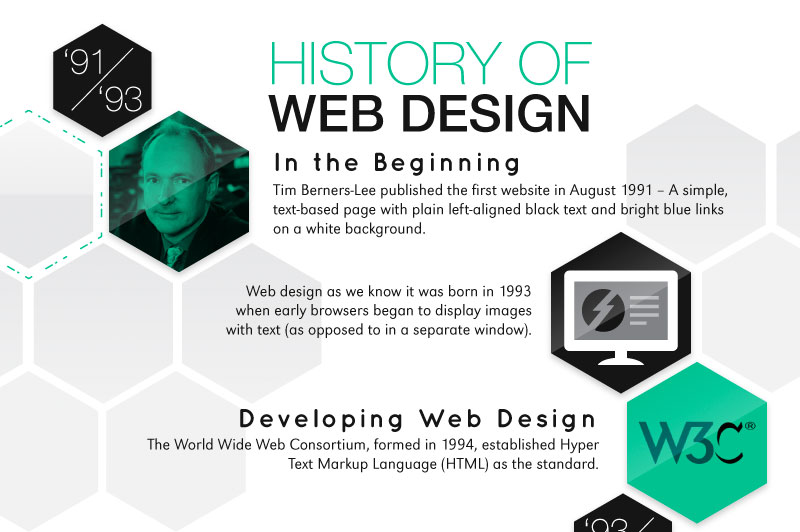Keen To Discover How Website Style Has Changed Over Time? Dive Into The Evolution From Simpleness To User-Focused Experiences
Keen To Discover How Website Style Has Changed Over Time? Dive Into The Evolution From Simpleness To User-Focused Experiences
Blog Article
Team Author-Kahn Hyldgaard
In the past, sites were basic and concentrated on information. Navigation was direct, and design was for desktop computers. Now, user experience is crucial. Data overviews designs for easy navigating. Receptive designs match different gadgets. Today, dark setting decreases stress, and minimalist menus improve navigation. Interactive attributes involve individuals, and vibrant visuals stand out. AI integration improves engagement. See exactly how design has progressed to boost your on the internet trip.
Very Early Days of Website Design
In the early days of website design, simplicity reigned supreme. Internet sites were basic, with restricted shades, fonts, and formats. discover this info here was on offering details rather than fancy visuals. Customers accessed the net via slow dial-up connections, so speed and capability were essential.
Navigating food selections were straightforward, generally situated on top or side of the web page. Internet sites were designed for desktop computers, as mobile browsing had not been yet common. Web content was king, and developers focused on very easy readability over complicated design components.
HTML was the main coding language utilized, and developers had to work within its restrictions. Computer animations and interactive features were marginal contrasted to today's requirements. Internet sites were fixed, with little vibrant content or personalized user experiences.
Rise of User-Focused Design
With the advancement of website style, a shift towards user-focused style concepts has actually ended up being significantly noticeable. Today, producing sites that focus on individual experience is critical for engaging site visitors and attaining company goals. User-focused design includes recognizing the demands, preferences, and behaviors of your target audience to tailor the website's design, content, and features accordingly.
Designers now conduct extensive research, such as individual studies and functionality testing, to gather insights and responses straight from users. This data-driven approach helps in producing user-friendly navigation, clear calls-to-action, and visually attractive user interfaces that resonate with site visitors. By putting the individual at the facility of the style procedure, websites can deliver a more personalized and satisfying experience.
Receptive layout has actually additionally emerged as an essential aspect of user-focused layout, ensuring that sites are maximized for various devices and screen sizes. This versatility improves access and functionality, dealing with the varied ways customers interact with websites today. In essence, the surge of user-focused style represents a change in the direction of creating electronic experiences that prioritize the needs and assumptions of the end individual.
Modern Trends in Website Design
Discover the most recent patterns forming website design today. One prominent trend is dark setting style, offering a streamlined and contemporary appearance while reducing eye strain in low-light environments. One more crucial fad is minimalist navigation, streamlining menus and boosting user experience by focusing on essential elements. Incorporating micro-interactions, such as computer animated switches or scrolling impacts, can create a more engaging and interactive site. Responsive layout stays critical, guaranteeing smooth user experiences throughout different gadgets. Additionally, using strong typography and asymmetrical layouts can include aesthetic passion and draw attention to particular web content.
Integrating AI technology, like chatbots for customer support or personalized referrals, enhances user interaction and enhances procedures. Ease of access has also end up being a significant trend, with developers prioritizing comprehensive layout practices to satisfy diverse individual demands. Embracing sustainability by enhancing web site efficiency for speed and performance is an additional arising trend in website design. Working together with customer responses and data analytics to iterate and improve style constantly is important for staying appropriate in the ever-evolving electronic landscape. By embracing these modern patterns, you can develop an aesthetically attractive, easy to use web site that resonates with your audience.
Verdict
As you assess the development of internet site style from the early days to now, you can see exactly how user-focused design has actually come to be the driving force behind contemporary trends.
Accept the trip of change and adaptation in website design, always maintaining the individual experience at the forefront.
Stay present with the current fads and innovations, and never stop advancing your technique to develop visually sensational and easy to use sites.
Progress, adapt, and develop - the future of website design remains in your hands.
